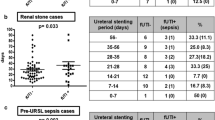Abstract
The aim of this study was to elucidate risk factors associated with postoperative febrile UTI after URS for urinary stones. Data from 153 patients undergoing URS for renal and/or ureteral stones between 2011 and 2013 at a single center were reviewed to detect factors predicting postoperative febrile UTI. URS for residual stones was excluded. Postoperative febrile UTI was defined as body temperature >38 °C and was graded according to the Clavien grading system. The definition of pyuria was 10 or more white blood cells per high power field. Median age of the patients was 57 (range 17–89) years. Of the 153 patients, 98 (64.1 %) were male, 10 (6.5 %) had Eastern Cooperative Oncology Group performance status 2 or greater, 14 (9.2 %) had Charlson comorbidity index 3 or greater. Before URS, 69 (45.1 %) had pyuria, 27 (17.6 %) had acute pyelonephritis, 42 (27.5 %) had ureteral stent, and 50 (32.7 %) were treated with antibiotics. After URS, 28 (18.3 %) developed febrile UTI (Clavien grade I, n = 16; grade II, n = 10; grade III, n = 1; grade IV, n = 1). Preoperative pyuria and acute pyelonephritis were significant factors for postoperative febrile UTI (pyuria: odds ratio 3.62, 95 % CI 1.26–8.11, P value 0.017; pyelonephritis: odds ratio 4.43, 95 % CI 1.06–11.16, P value 0.044). Degree of pyuria was likely to be associated with severity of postoperative febrile UTI, and two cases (1.3 %) with severe pyuria developed sepsis. Careful management is needed for patients with preoperative pyelonephritis or pyuria; risk factors for postoperative febrile UTI to avoid sepsis.
Similar content being viewed by others
References
European Association of Urology (2015) Guidelines on urolithiasis. http://uroweb.org/guideline/urolithiasis/. Accessed 24 Aug 2015
de la Rosette J, Denstedt J, Geavlete P et al (2014) The clinical research office of the endourological society ureteroscopy global study: indications, complications, and outcomes in 11,885 patients. J Endourol 28:131–139
Daels FP, Gaizauskas A, Rioja J et al (2014) Age-related prevalence of diabetes mellitus, cardiovascular disease and anticoagulation therapy use in a urolithiasis population and their effect on outcomes: the Clinical Research Office of the Endourological Society Ureteroscopy Global Study. World J Urol
Arbuck SG, Ivy SP, Setser A et al (1999) The Revised Common Toxicity Criteria: Version 2.0. Available at http://ctep.info.nih.gov
Charlson ME, Pompei P, Ales KL, MacKenzie CR (1987) A new method of classifying prognostic comorbidity in longitudinal studies: development and validation. J Chronic Dis 40:373–383
Dindo D, Demartines N, Clavien PA (2004) Classification of surgical complications: a new proposal with evaluation in a cohort of 6336 patients and results of a survey. Ann Surg 240:205–213
Ozsoy M, Acar O, Sarica K et al (2014) Impact of gender on success and complication rates after ureteroscopy. World J Urol 2014 (Epub ahead of print)
Sohn DW, Kim SW, Hong CG, Yoon BI, Ha US, Cho YH (2013) Risk factors of infectious complication after ureteroscopic procedures of the upper urinary tract. J Infect Chemother 19:1102–1108
Eswara JR, Shariftabrizi A, Sacco D (2013) Positive stone culture is associated with a higher rate of sepsis after endourological procedures. Urolithiasis 41:411–414
Youssef RF, Neisius A, Goldsmith ZG et al (2014) Clinical outcomes after ureteroscopic lithotripsy in patients who initially presented with urosepsis: matched pair comparison with elective ureteroscopy. J Endourol 28:1439–1443
Lumma PP, Schneider P, Strauss A et al (2013) Impact of ureteral stenting prior to ureterorenoscopy on stone-free rates and complications. World J Urol 31:855–859
Shields JM, Bird VG, Graves R, Gómez-Marín O (2009) Impact of preoperative ureteral stenting on outcome of ureteroscopic treatment for urinary lithiasis. J Urol 182:2768–2774
Rubenstein RA, Zhao LC, Loeb S, Shore DM, Nadler RB (2007) Prestenting improves ureteroscopic stone-free rates. J Endourol 21:1277–1280
El-Nahas AR, El-Tabey NA, Eraky I et al (2009) Semirigid ureteroscopy for ureteral stones: a multivariate analysis of unfavorable results. J Urol 181:1158–1162
Rippel CA, Nikkel L, Lin YK et al (2012) Residual fragments following ureteroscopic lithotripsy: incidence and predictors on postoperative computerized tomography. J Urol 188:2246–2251
Matsumoto M, Shigemura K, Yamamichi F et al (2012) Prevention of infectious complication and its risk factors after urological procedures of the upper urinary tract. Urol Int 88:43–47
Geavlete P, Georgescu D, Niţă G, Mirciulescu V, Cauni V (2006) Complications of 2735 retrograde semirigid ureteroscopy procedures: a single-center experience. J Endourol 20:179–185
Troxel SA, Low RK (2002) Renal intrapelvic pressure during percutaneous nephrolithotomy and its correlation with the development of postoperative fever. J Urol 168:1348–1351
Author information
Authors and Affiliations
Corresponding author
Ethics declarations
Conflict of interest
None declared.
Rights and permissions
About this article
Cite this article
Mitsuzuka, K., Nakano, O., Takahashi, N. et al. Identification of factors associated with postoperative febrile urinary tract infection after ureteroscopy for urinary stones. Urolithiasis 44, 257–262 (2016). https://doi.org/10.1007/s00240-015-0816-y
Received:
Accepted:
Published:
Issue Date:
DOI: https://doi.org/10.1007/s00240-015-0816-y




